|
|
|
 North Korea Under Kim Il-sung’s One-Man Rule
North Korea Under Kim Il-sung’s One-Man Rule |
|
| Kim Il-sung Solidifies One-Man Rule |
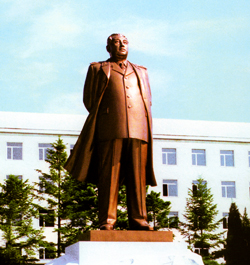 |
| Kim
Il-sung’s unchallenged power laid the
foundations for his idolization and
the future succession of power |
|
During the 1970s, Kim Il-sung established a system
where the entire nation of North Korea came under
a one-man rule, with himself as President and his
son, Kim Jong-il, as his successor. A cult of personality,
bordering on deification, developed around Kim and
his son, laying the groundwork for Kim Jong-il’s
future rise to power. Naturally, those that opposed
this ‘dynastic’ system were singled out for purges.
It was the new constitution that laid down the one-man
rule system in written law.
At the 1st meeting of the 5th SPA held in December
1972, a new ‘Socialist Constitution’, superseding
the ‘Constitution of the People’s Republic’ of 1948,
was announced. It reorganized the political bodies
and institutional organizations around the President,
completing Kim’s one-man rule system.
The ‘Socialist Constitution’ served as the backbone
of North Korea’s legal system until major revisions
were made in 1992 to accommodate Kim Jong-il’s succession
to power. Kim Jong-il began his ‘apprenticeship’
in September 1973, taking public office as a Party
Secretary. Meanwhile, the purging process against
those opposed to Kim Jong-il’s succession continued,
during which Kim Il-sung’s younger brother Kim Young-ju
and several military leaders including Kim Dong-gyu,
Rhee Yong-mu, and Ryu Jang-sik were eliminated in
1973 |
|
| The 7.4 Joint Statement |
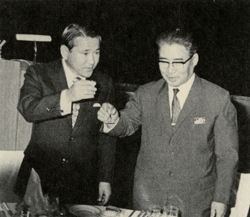 |
| The
main figures of the 7.4 Joint Statement:
South Korea KCIA Chairman Lee Hu-rak
(left) and North Korea Vice-Chairman
Park Sung-chol (right) |
|
Clandestine contact between the North and South’s
leaders led to the ‘7.4 Joint Statement’ of 1972.
Following secret meetings held in Panmunjeom,
other secret meetings in Seoul and Pyongyang between
South Korea’s KCIA Chief Lee Hu-rak and North
Korea’s 2nd Vice Premier Park Sung-chul culminated
in the joint statement, which was announced simultaneously
by both Seoul and Pyongyang. Loosely centered
on principles of peace on the Peninsula and initiatives
to begin North-South dialogue, the joint statement
consisted of :
① the ‘three pillars of reunification’ - independence,
peace, and solidarity among the Korean people,
② refraining from denouncing each other and forbidding
the use of military force,
③ implementing various North-South cooperative
initiatives,
④ cooperation in Red Cross operations,
⑤installing a North-South communications hotline,
⑥ establishing a North-South Coordination Committee,
⑦ and faithfully observing the contents of the
joint statement. Although the North and South
failed to alter their fundamental positions regarding
the issue of reunification, the joint statement
was nevertheless a sensational happening in that
a direct channel of political communication had
been established between the leaderships of the
two states.
From a North Korean point of view, the joint statement
provided an opportunity to burnish Kim Il-sung’s
completion of a one-man rule system. Economically,
the statement was intended to reverse the North’s
shortcomings compared to the South’s. Meanwhile,
from an external perspective, the statement indicated
that North Korea was diversifying its approach
to diplomacy. The political stability in North
Korea afforded by the statement continued throughout
the 1970s until Kim Il-sung’s death in 1994.
|
|
| Diversification of Diplomacy |
North Korea initially carried out limited diplomacy
only with communist states such as China and the
Soviet Union. However, the rift in the communist
camp prompted North Korea to establish relations
with neutral states in the 1960s. In the 1970s,
diplomacy with so-called western states was pursued
as well. Several developments in the international
arena contributed to this change
: China’s admission to the U.N. in 1971, the thawing
of U.S.-Sino relations following President Nixon’s
visit to China in 1972, the normalization of Sino-Japanese
relations, and the concurrent debate between the
two Koreas in the U.N. and other international
organizations.
|
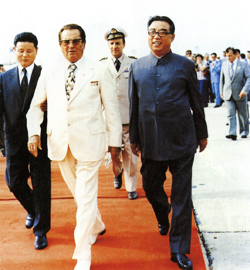 |
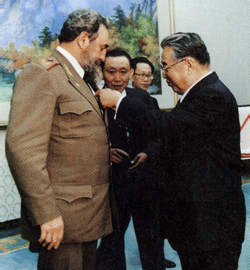 |
Kim
Il-sung and Yugoslav leader Tito
|
|
Kim
Il-sung confers a decoration
to Fidel Castro |
|
|
In the 6th Party Meeting held in October 1980,
the North Korean leadership announced three fundamental
principles in its diplomatic policy - self-reliance,
friendship, and peace - and proceeded to pursue
more diversified diplomatic relations with ‘western’
states.
Efforts to build relations with the U.S. were
also pursued during this time. In January 1984
‘new measures to spur on Korean detente were discussed
by the SPA and the Central People’s Committee,
and a proposal was even made to hold three-party
talks between the two Koreas and the U.S.
|
|
|
|
 The Economy Comes Under Pressure
The Economy Comes Under Pressure |
|
 |
| The
Kim Chaek Steel Forgery: North Korea’s
largest steel manufacturing plant, located
in Chongjin of North Hamgyung Province.
Shortage of raw materials occasionally
halted operation of the plant. |
|
North Korea enjoyed a period of relative stability
during the 1970s and 1980s under Kim’s solidified
one-man rule.
However, the limitations of socialism soon threatened
to bog down the North Korean economy. Socialist
labor competition schemes, aid from other communist
states, and planned economy policies had previously
combined with North Korea’s advantageous industrial
infrastructure to create an illusion of rapid
economic growth.
However, the Soviet Union’s economic aftermath
of Stalinist growth schemes, the Soviet-Chinese
divide, equidistance diplomacy by North Korea,
the innate limitations of North Korea’s mobilization-reliant
economic structure and its economic alienation
from major global market economies combined to
stunt economic growth. The economic gap between
the two Koreas has widened steadily ever since
the 1970s.
|
|
| The 1st Six-Year Plan (1971∼1976) |
This plan was launched at the 5th Party Meeting
in 1970 with the objective of realizing the ‘three
major technological revolutions’ and enhancing
the industrial structure of North Korea. It is
notable that the roles of technology and capital
were emphasized, in recognition of the limitations
of the mobilization-reliant economic structure.
Thus, the plan focused on adopting technology,
capital, and equipment from western states. However,
foreign debt became a pronounced problem by 1975,
as loans from foreign states and bills for imported
goods were not paid on time.
In addition, limitations of North Korea’s chain-of-command
approach to economic policy amid expanding economic
scale brought about serious problems in social
infrastructure such as energy and transportation
sectors. The six-year plan was trumpeted as a
success in 1975, having supposedly achieved its
goals 18 months ahead of schedule.
In reality, however, this was more of an abortive
measure as it became apparent that drastic modifications
were needed in terms of economic planning. Consequently,
North Korea announced a two-year long ‘buffer
period’, during which efforts to repair ailing
sectors of its economy were pursued.
|
|
| The 2nd Seven-Year Plan (1978∼1984) |
This plan emphasized the creation of a self-reliant,
modernized, and science-driven economy. National
income was to be increased to 1.9 times its 1977
level, while gross production of industrial goods
and grains was to be boosted 2.2 times and to
10 million tons, respectively.
An announcement was made in February 1985 that
all stated objectives had been accomplished by
the end of 1984. As with the previous six-year
plan, the enactment of a two-year buffer period
following this announcement implied that the plan
was a failure. Some notable features of the 2nd
Seven-Year Plan include :
△the implementation of additional goals such as
the 'ten objectives for building a socialist economy
for the late 1980s’ and the ‘four areas of development
in natural resources’ and
△interest in a more opened economy, such as the
expanded pursuit of external economic projects,
trade, and the promulgation of the ‘joint business
act’
|
|
| The Joint Business Act |
This law was announced at an SPA meeting on
September 8, 1984 with the objective of pursuing
economic/technological exchange with foreign states
and joint investment projects. Officially known
as ‘Act on the Operation of Joint Businesses’,
it was intended to secure fuels, raw materials,
technology, and capital to invigorate the overall
economy and meet the economic needs of the people.
The act was essentially a sign of acknowledgment
that the economy was stagnating and that obtaining
further foreign loans would be difficult. Further
legal and institutional devices were provided
in March 1985 in the form of ‘regulations concerning
the operation of joint businesses’ and the ‘foreigner
income tax’. Key participants in such projects
were other communist states as well as pro-communist
Koreans living in China, Russia, and Japan. North
Korea also attempted to attract investment from
market economies such as South Korea, Japan, Taiwan,
Hong Kong, the U.K., France, and Australia.
|
|
| The 3rd Seven-Year Plan (1987∼1993) |
As with the 2nd seven-year plan, the 3rd also
aimed to realize a self-reliant, modernized, and
science-driven economy. National income was to
be increased 1.7 times (average annual growth
of 7.9%), while gross production of industrial
goods and grains was to be boosted 1.9 and 1.4
times respectively. Some of the ‘ten objectives’
were modified to include new production and construction
objectives. Key features of the 3rd seven-year
plan include :
△scaled-down objectives, reflective of the overall
economic stagnation at the time,
△top priority on technological innovation, and
△further emphasis on trade and economic cooperation
with foreign states. North Korea expressed an
increased willingness to open up its economy by
announcing the ‘Najin-Sunbong Free Trade Zone’
in connection with the UNDP (United Nations Development
Program)’s Tumen River delta development project.
To compete with the 1988 Seoul Olympic Games,
North Korea mobilized large proportions of labor
and capital investment to hold the 13th World
Festival of Youth and Students, but saw little
overall progress. The downfall of North Korea’s
economic partners following the collapse of the
Soviet Union and the eastern European communist
states, a politics-dominated national agenda,
the general lack of material resources, and other
negative factors led to the plan’s utter failure.
National income grew to only 61% of what was originally
planned, while net exports stopped short at 52.5%
and growth in other key sectors remained at 20~50%
of targeted levels. For the first time, North
Korea had no choice but to officially acknowledge
its failure.
|
|
|
|
 Change of North-South Relations
Change of North-South Relations |
|
Conversations between the leadership of both
Koreas saw little progress following the 7.4 Joint
Statement of 1972. Any communication that did
take place soon devolved into bickering and most
of the contents of the joint statement were not
observed. However, some essential changes were
underway in North-South relations.
The tense atmosphere and animosity had subsided
partially, and intermittent events such as Red
Cross talks, reunions between separated family
members, and provision of relief aid took place.
By the end of Kim Il-sung’s rule, economic cooperation
projects were being discussed on a practical level.
Although cancelled by Kim Il-sung’s death in 1994,
a North-South summit meeting had been pursued
up until then.
|
|
| The North-South Red Cross Talks and the Meetings of Separated Families
|
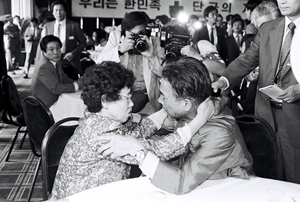 |
| The
first separated-family reunions were
held in 1985 |
|
On August 12, 1971, the South Korean Red Cross
proposed to its northern counterpart via KBS radio
broadcasts that a meeting be held between family
members separated during the Korean War.
Two days later, the North Korean Red Cross consented
through Pyongyang Broadcasting, leading to North-South
Red Cross talks. However, the 1st and 2nd round
of talks produced little results other than five
basic principles to be observed concerning the
meetings between separated families: to confirm
the addresses of separated family members (if
alive), free visiting and gathering, free exchange
of letters, and other specifics in accordance
with humanitarian principles. Talks resumed after
the North Korean Red Cross announced it would
provide relief for massive floods that struck
South Korea in 1984.
Three rounds of talks led to an agreement to hold
reunions for separated families. From September
20th to 23rd, 1985, the chairmen of both Red Crosses
led 151 family members to Seoul and Pyongyang.
There were moving scenes as family members were
able to reunite, albeit temporarily and under
strict supervision, for the first time in over
three decades. Most people previously had no idea
whether their family members were alive or dead.
However, no such meetings would take place again
until the 2nd reunion event in the year 2000.
|
|
| Civilian-level Economic Cooperation |
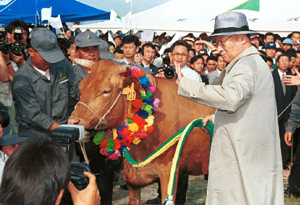 |
| The
late Jung Joo-young, President of the
Hyundai Group, leads his herd of cattle
to the North |
|
Improvements in North-South relations did not
occur only in the form of humanitarian efforts
such as the meetings of separated families and
supply of relief aid. Though extremely limited,
various transactions and exchanges between the
two Koreas were beginning to take place, sending
signals that the divide was slowly being overcome.
Foundations were being laid for civilian-level
economic cooperation, while some transactions
were realized between South Korean corporations
and North Korea. One notable incident was the
visit paid by Jung Ju-young, president of the
Hyundai Group at the time, to Pyongyang. Jung
met with most North Korean leaders including Kim
Il-sung before his return to Seoul.
The visit signaled the beginning of actual North-South
economic cooperation, embodied in a project to
send South Korean tourists to the famed Mt. Geumgang
in North Korea. Although the project was initially
a far-fetched idea and was not realized until
ten years later, the very possibility that ordinary
South Korean citizens, not political figures,
could freely visit North Korean territory earned
it a place in history. |
|
|
 |
|